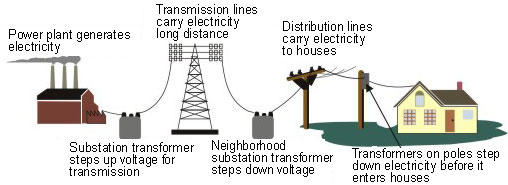Energy Storage and the Electricity Grid
Because renewable energy like wind and solar comes from nature, its supply is also subject to natural processes. That means that solar energy is produced only during the day, and wind energy only when the wind is blowing. While this might seem obvious, the intermittent flow of electricity from renewables is one of the reasons why renewable energy can be difficult to integrate into the electricity grid.
Defining the Grid
The electricity grid is in some ways very simple, and in other ways very complex. At a base level, however, the grid is the system of infrastructure that provides electricity produced at power plants to homes, schools, businesses, factories and anything else you can imagine. To transport this electricity, there are four parts of the grid at play:
- Individual Generators: From wind farms to coal plants, all industrial power plants are connected to the grid.
- Transmission Lines: Once these power sources are connected to the grid, transmission lines help transport the electricity. Power plants are often not located in residential areas, so these lines cover longer distances.
- Distribution Lines: After the electricity is transported to a more local level, smaller but more numerous distribution lines carry electricity to individual buildings.
- Load, aka Consumer Usage: Although not a physical component, load—or the electricity demand that consumers place on the grid—is the most important part of the process. After all, without people using the electricity, we wouldn’t have a need for such complex infrastructure.

Photo: EIA
The Renewable Energy Problem
As you may have noticed in the above diagram and description, what our current electricity grid does not include is any sort of energy storage. This means that when electricity is produced, it immediately flows along the transmission and distribution lines and gets used. With the current mix of renewable, nuclear and fossil fuel power sources, electricity managers turn power plants on and off to meet the current electricity needs.
But let’s imagine for a second if instead of a mixed energy portfolio, all the electricity came from renewable sources. While this would be great for our carbon footprint, it might create a huge problem with our current grid. During the day and when it is windy, solar and wind power might actually provide too much electricity—meaning that it might not be used, or worse might actually overload the grid since there is no built in storage mechanism. At night, when this energy is no longer being produced but people still want electricity, there would be outages.
Energy Storage and Smart Grids
The obvious solution, then, is integrating methods to store electricity in the grid and increasing renewable energy in our grid that provides a “base load” of consistent energy 24/7, such as geothermal, to replace the “base load” of nuclear energy going offline. With storage, the extra solar or wind power from peak production times can be saved up for times with higher demand. Proposed ways to do this range from giant batteries to something known as the smart grid.
In reality, “smart grid” is a phrase that has come to reference nearly any grid improvement. Given that the American Society of Civil Engineer’s has granted the US energy/grid system a D+, these improvements can come in a range of areas from cybersecurity to electricity storage capabilities. When it comes to renewables, it is the electricity storage capabilities that we care about. Smart grids can also allow for more numerous, small sources of power—like rooftop solar—to be easily integrated into the total electricity supply.
Audubon California supports renewable energy when it is sited properly to avoid, minimize or mitigate effectively for impacts on birds, other wildlife and habitat.
How you can help, right now
Get Audubon CA in Your Inbox
Our newsletter is fun way to get our latest stories and important conservation updates from across the state.
Donate to Audubon
Help secure the future for birds at risk from climate change, habitat loss and other threats. Your support will power our science, education, advocacy and on-the-ground conservation efforts.
HOTSPOT: Flyover of California's Birds and Biodiversity
California is a global biodiversity hotspots, with one of the greatest concentrations of living species on Earth.



